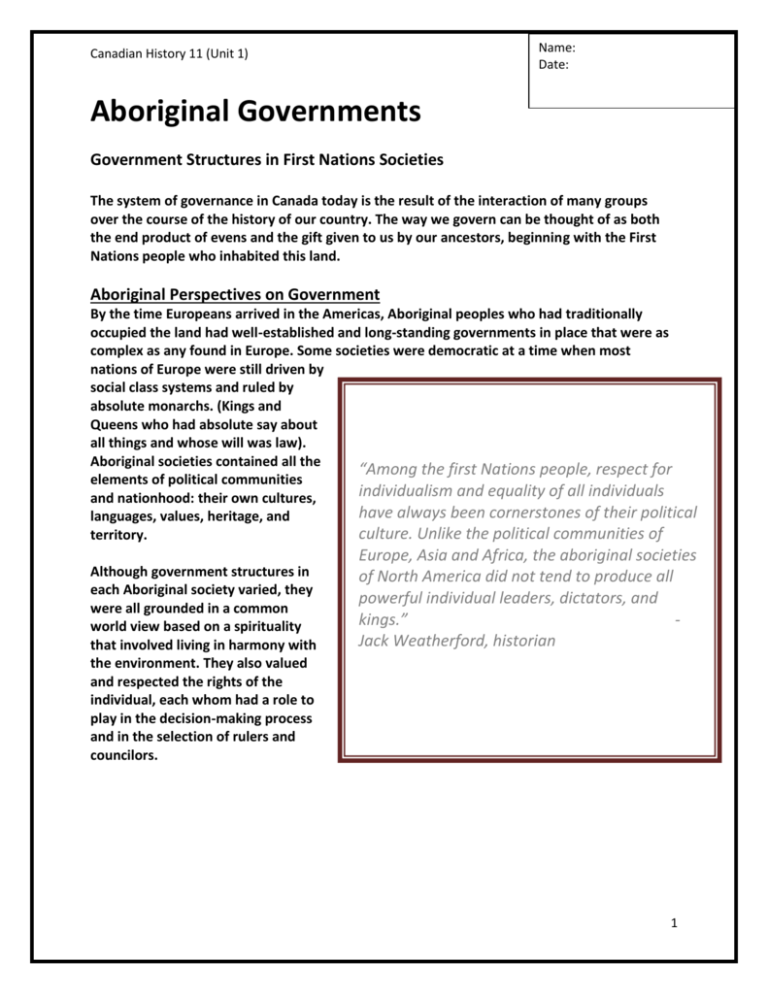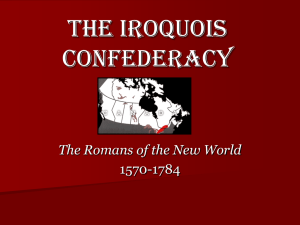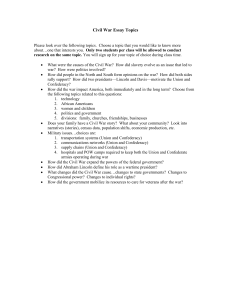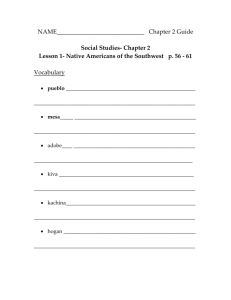File
advertisement

Name: Date: Canadian History 11 (Unit 1) Aboriginal Governments Government Structures in First Nations Societies The system of governance in Canada today is the result of the interaction of many groups over the course of the history of our country. The way we govern can be thought of as both the end product of evens and the gift given to us by our ancestors, beginning with the First Nations people who inhabited this land. Aboriginal Perspectives on Government By the time Europeans arrived in the Americas, Aboriginal peoples who had traditionally occupied the land had well-established and long-standing governments in place that were as complex as any found in Europe. Some societies were democratic at a time when most nations of Europe were still driven by social class systems and ruled by absolute monarchs. (Kings and Queens who had absolute say about all things and whose will was law). Aboriginal societies contained all the “Among the first Nations people, respect for elements of political communities individualism and equality of all individuals and nationhood: their own cultures, have always been cornerstones of their political languages, values, heritage, and culture. Unlike the political communities of territory. Although government structures in each Aboriginal society varied, they were all grounded in a common world view based on a spirituality that involved living in harmony with the environment. They also valued and respected the rights of the individual, each whom had a role to play in the decision-making process and in the selection of rulers and councilors. Europe, Asia and Africa, the aboriginal societies of North America did not tend to produce all powerful individual leaders, dictators, and kings.” Jack Weatherford, historian 1 Canadian History 11 (Unit 1) Structures of Government in Aboriginal Societies The Mi’kmaq Nation Before the arrival of Europeans, much of what is today the Maritime provinces was occupied by the Mi’kmaq. At the time of contact, the basic political unit in Mi’kmaw society was the extended family which consisted of 30-200 people led by a chief. At the heart of Mi’kmaw political cultures were two fundamental principles: One was the respect for the rights of the people Respect for, and the preservation of, the environment The Mi’kmaq nation had a well-established system of self government that was based on the democratic principles. Leaders were appointed by the people and could be removed at the people’s discretion. Mi’kmaw communities placed considerable importance of the opinions of the Elders, both male and females. Disputes were settled through mediation in which a just settlement for both parties was sought under the watchful eye of the leaders and the community as a whole. Once an agreement was reached, both parties were expected to abide by it. Mi’kmaw territory was decided into seven geographic districts. Each district had its own government in the form of an elected District Chief who presided over a Council of Chiefs made up of Elders and other distinguished members of the community. The district Councils had many of the powers we associate with a central government today, such as the power to grant hunting and fishing territories, to settle disputes, and to make war or peace. The Mi’kmaq Nation also had a council called the Grand Council, consisted of the seven District Chiefs. Its role was to discuss matters of mutual interest among the seven District councils., resolve disputes among them, and the negotiate mutually satisfactory agreements. One of the seven members was selected to be Grand Chief. Since all chiefs were elected, the Grand Council generally was made up of individuals who were respected in their communities. A chief could remain in office as long as he retained the confidence of the people. The Mi’kmaq Grand Council has survived through the ages. 2 Canadian History 11 (Unit 1) Its role today is to provide spiritual leadership. Day-to-day governance in Mi’kmaw communities is provided by elected chiefs and councils. Questions on the Mi’kmaq Nation The Iroquois Confederacy The Iroquois Confederacy which can be traced back to 1142 , ( 900 years ago), originally consisted of five First Nations living south of Lake Ontario who had banded together: the Mohawks, the Oneida, the Onondaga, the Cayuga, and the Seneca. They were joined in 1722 by the tribe of the Tuscaronras, who were forced to move at that time. The Confederacy then became known as the Six Nations The Confederacy was founded by a man named Dekanahwideh. At that time, 1142, the five tribes were continually at war with each other. He traveled to each of the Nations to encourage them to join together under the Great Law of Peace. The people of the Iroquois confederacy were accomplished farmers. Farming enabled them to establish permanent communities. They developed a complex system of government based on democratic principles. The power to govern started with the individual and flowed to the family, then to the clan, to the village and then to the nation, to the Confederacy. It emphasized the important of the individual and that one person could make a difference. The symbol of the Confederacy was the longhouse, a rectangular building that was the traditional home of the Iroquois. What is interesting about this Iroquois nation is that it was matrilineal or that it traced its clans and extended families through the mother. Although men became chiefs, they were selected by the oldest woman in the clan, called the Clan Mother, who also held the balance of power and had the authority to remove a chief from power and appoint a new chief. In addition, women had many other influential roles, including acting as caretakers of the land, controlling the economic interest of the family, and educating younger generations. For the Iroquois, all clan chiefs in a village made up what was called the village council. This Council selected a village chief, who represented the village on the Nations Council. In turn the Nations Council selected a chief to represent it on the Confederacy Council/ The 3 Canadian History 11 (Unit 1) Confederacy Council practiced a form of representative democracy if which votes were given to delegates from all Nations. Decision of the council required everyone to agree. Here is how it starts with the Clan Mother, who selects a Clan Chief, who will go to the Village Council. OF all the Clan Chiefs, one will be chosen to represent the village at the Nations Council. At the Nations Council, one person will be chosen to represent the tribe at the Confederacy Council Clan Chief- selected by Clan Mother- Oldest Woman in the Clan (family) Questions on Iroquois Confederacy 1. Explain why we say that this Native Group is Matriarchal? Village Council was made up of all the Clan Chiefs. Individual chosen by the Village council from its members to go to the Nations Council 2. What is the Longhouse? Chief would be selected from the representatives at the Nations Council to go to the Confederacy Council The Concept of Property Ownership One of the biggest differences between Aboriginal peoples and Europeans was the concept of property ownership. Aboriginal peoples did not consider the land as something that they could own as individuals or as a society. Instead, they considered the land to be a sacred trust that was theirs to use and preserve during their lifetimes and to pass on to the next generation. They would defend the land if they need to by force when necessary. On the other hand, the concept of property ownership was important in European law. Land was owned in the same way that other property, such as guns, books and clothing, was owned. When European explorers arrived at what they considered to be “new lands” in North America, they claimed the territories and all the resources for their king. The King in turn gave land rights to certain members of the upper classes, who assumed the land was theirs to exploit at their will. 4 Canadian History 11 (Unit 1) As Europeans expanded their territories, Aboriginal nations began to claim title to the lands they traditionally occupied. Although many Aboriginal cultures followed distinct natural patterns of migration, they claimed title based on the fact that their migrations were confined to definable territories that were not occupied or claimed by any other Aboriginal nations. When Aboriginal peoples resisted the takeover by Europeans of the lands they occupied, violence and sometimes wars broke out with the colonists. By the eighteenth century, colonial and European leaders realized that to ensure the safety and security of their settlements, they had to reach agreements with local First Nations peoples. Aboriginal Treaties Long before Europeans arrived in North America, Aboriginal societies were negotiating treaties with one another. They used treaties to establish who would use the land and how it would be used. It was the nature of their culture to honour and respect these treaties. 5







